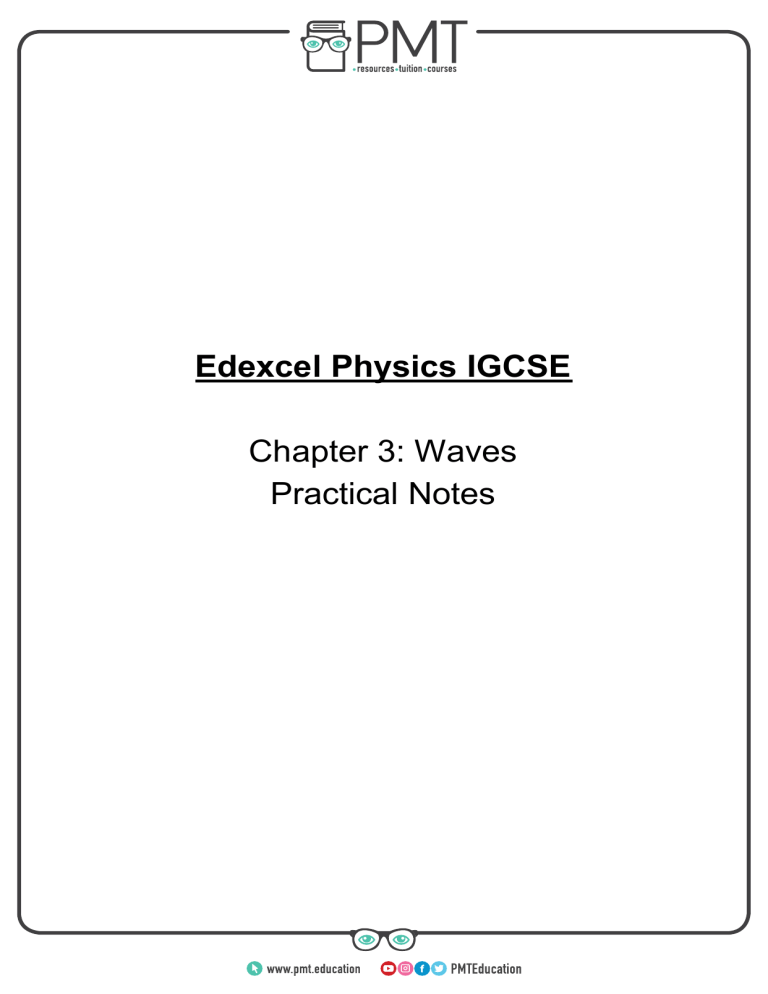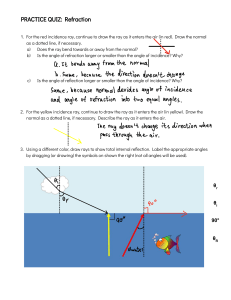
Edexcel Physics IGCSE Chapter 3: Waves Practical Notes www.pmt.education Investigate the Refraction of Light using Rectangular Blocks, Semi-Circular Blocks and Triangular Prisms Equipment: ● Glass blocks (rectangular, semi-circular and triangular) ● Power supply ● Ray box with a single slit ● Protractor ● Paper Method: 1. Connect the ray box to the power supply and insert the single slit slide so that it produces a clear and thin beam of light. 2. Place one of the blocks onto the sheet of paper and draw around it. 3. Remove the block and then mark the position on the outline that you are going to shine the light ray at with a cross. 4. Using a protractor, draw a normal to that point (a perpendicular line). 5. Mark on a selection of different angles of incidence by measuring angles from the normal line. 6. Replace the block on top of the outline, and then shine the ray of light along each incident line. For each angle, mark the position on the other side of the block where the light exits. 7. Turn off the ray box and remove the block. 8. Using a ruler, connect up the entry position and the exit position for each angle of incidence. 9. Using a protractor, measure the angles of refraction (the angles that the lines inside the block outline make with the normal) for the different angles of incidence. 10. Repeat for the other two shaped blocks and compare results. Tips: ● To ensure you can see the light rays clearly, it may help to work in a darkened laboratory. ● Use a sharp pencil so that the lines are clear and the angle measurements are as accurate as possible. Safety Precautions: ● The ray box will get very hot so avoid touching any metal surfaces during and just after use. ● Turn the ray box off when not in use to prevent it overheating. ● Don’t look directly at the ray box light. www.pmt.education Investigate the Refractive Index of Glass Using a Glass Block Equipment ● ● ● ● ● ● Ray box and single slit grating to create a narrow beam Glass block Paper Pen/pencil Ruler Protractor Method 1. Set up the experiment in a darkened room. 2. Place the glass block on the paper and draw around it to ensure that the block will always be in the same place even if you remove it and replace it. 3. Using the protractor, draw a line that is 90º to the surface of the glass block (this is the ‘normal’). ○ It may be easier to move the block and work from the outline on the paper for this part since you need to continue the line into the glass block outline. 4. Draw three lines as guides for the angles you are going to direct the light into the block. ○ These will hit the block at the point where you drew the normal. ○ Example angles are 20º, 40º and 60º. 5. Direct the light along each of these lines in turn and, for each one, make markings where the light leaves the block on the other side. ○ This can be done by drawing dots or Xs and joining them together with a ruler once you have moved the block out of the way. 6. Connect the point of incidence to the point where the light leaves the block for each angle, which should leave you with something like the diagram below. ○ Ensure that there is a normal line (90º to the surface of the glass as before) at each point where the light leaves the block. 7. Use the protractor to measure all the angles of incidence and refraction and mark these on the paper. ○ The angle of incidence where the light initially hits the block should be equal to, or very close to, the angle where the light is leaving the block. ○ Always measure angles from the normal to the path of the light. sin(i) 8. The refractive index of glass when light enters from air is given by n = sin(r) , where ‘i’ is the angle of incidence and ‘r’ is the angle of refraction. 9. Use the angles you measure to calculate the refractive index of the glass block. ○ If the values vary, take the average. www.pmt.education Safety Precautions ● ● Do not touch the ray box when it is in use or just after it has been used – it heats up and could cause burns if handled, before it has cooled down. Take care in a darkened room – there may be trip hazards that are less visible when the lights are dimmed. Diagram www.pmt.education Investigate the Speed of Sound in Air (Physics Only) Echo Method: Equipment: ● ● ● ● Two blocks of wood Large open space Stopwatch Partner Method 1. Measure the distance from one side of the open space to the other side using a trundle wheel or long tape measure, marking with a marker the start and end point of your measurement. 2. One of your pair should stand at one marker with the wooden blocks, and the other should stand at the other marker with a stopwatch. 3. Once both ready, the block holder should strike the two blocks together. 4. At the instant they see the blocks touch, the other person should start the stopwatch. 5. At the instant they hear the sound, they should stop the stopwatch. 6. This should be repeated 10 times. 7. The speed should be calculated using: Speed = distance / time. 8. An average speed for all repeats should be calculated. Tips: ● The larger the distance, the more accurate your experiment is going to be. ● The value is affected by human reaction time and so the larger the distance, the smaller the percentage of that value the reaction time will be and the more accurate the value will be. ● The speed of sound in air should be around 330 m/s. ● This is a good opportunity to consider the difference between accuracy and precision - how close is your value to the true value and how close is it to your average value? www.pmt.education Investigate the Frequency of a Sound Wave Using an Oscilloscope (Physics Only) Equipment: ● ● ● Microphone Oscilloscope Instrument tuner Method 1. Connect the microphone to the oscilloscope and check that waveforms are produced when sounds are made. You may need to alter the oscilloscope settings to ensure that the wave forms fill the screen and are clear. 2. Make a sound using an instrument or by humming a note, and then press the hold button on the oscilloscope so that the wave-form produced is frozen. 3. Measure the distance between two peaks, and then by referring to the time base, calculate the length of time between the peaks. 4. This time is the time taken for one wave to be produced and is known as the time period. 5. To calculate the frequency of the wave, use: f =1/T. Tips ● ● To check the accuracy of your measurement, an instrument tuner or app can tell you the frequency of the wave being produced, and this can be compared to your measure value. To get the clearest waveform, a pure tone producer is best, since humming and instruments have various overtones to their sound which can confuse the oscilloscope waveform. www.pmt.education


